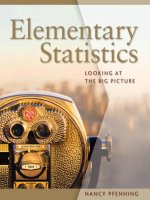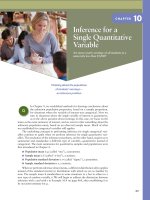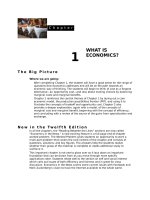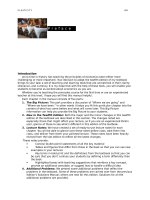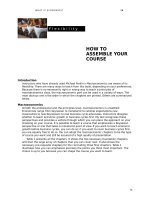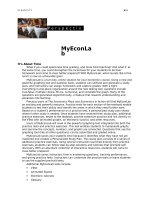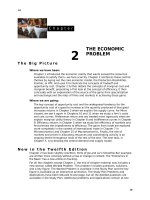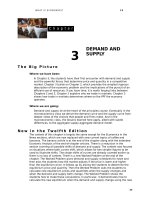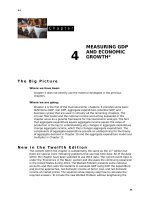The big picture marcoeconomics 12e parkin chapter 07
Bạn đang xem bản rút gọn của tài liệu. Xem và tải ngay bản đầy đủ của tài liệu tại đây (305.95 KB, 12 trang )
W H AT I S E C O N O M I C S ?
59
C h a p t e r
The Big Picture
Where we have been:
7
FINANCE, SAVING,
AND
INVESTMENT**
This chapter builds on the
definition of real GDP from Chapter 4 to explain how investment is financed. It
also uses the demand and supply model explained in Chapter 3. The chapter
explains how equilibrium in the loanable funds market determines the real
interest rate and quantity of investment. It also discusses how government
actions affect this market.
Where we are going:
Chapter 7 is the second of four chapters that examine the economy in the long
run when the economy is at full employment. The following chapters focus on
money and the price level, and the exchange rate and balance of payments.
After these chapters the next section examines macroeconomic fluctuations by
developing the AS-AD model. The material presented in Chapter 7 is used in
many of the following chapters. For instance the result that the real interest
rate is determined in the loanable funds market is important in the next
chapter to help determine the long-run effects from changes in the quantity of
money. The loanable funds model also is used in Chapter 13 when examining
the supply-side effects of fiscal policy.
N e w i n t h e Tw e l f t h E d i t i o n
A substantial change in this chapter is the omission of the global financial market
section which has been moved to Chapter 9. The chapter now concentrates
exclusively on the domestic loanable funds market. There also have been
substantial changes to the Economics in Action boxes in this chapter reflecting
data and events that have occurred since 2008 but the main content and flow of
the chapter is very similar to the 11 th edition. The Federal Reserve was added as a
key financial institution. The first Economics In Action box has been expanded with
new graphs added highlighting home mortgage debt. Two new Economics In
Action boxes show real vs. nominal interest rates and the allocation of loanable
funds to various agents. The Global Loanable Funds Market Section has been
moved to chapter 9. The Economics In The News has 2014 article discussing
interest rates on government bonds. The Worked Problem explores the loanable
funds market by giving data on the nominal interest rate, real interest rate,
investment, and government budget deficit in 2005 and 2007. The questions ask
the students the inflation rate in the two years, how the price of bonds changed
between the years, and what happened to the demand for loanable funds
between the years. It also asks them about crowding out and its effect on saving
59
60
and investment. To include the new Worked Problem without lengthening the
chapter, some problems have been removed from the Study Plan Problem and
Applications. These problems are in the MyEconLab and are called Extra Problems.
60
Lecture Notes
Finance, Saving, and Investment
•
•
The supply and demand for loanable funds determine the real interest rate and the
quantity of loanable fund and investment.
Government budget deficits might also affect the real interest rate and quantity of
investment.
I. Financial Institutions and Financial Markets
Finance and Money; Capital and Financial Capital
•
•
Finance and money differ:
• Finance refers to providing the funds used for investment.
• Money refers to what is used to pay for goods and services.
Capital and financial capital differ:
• Capital consists of physical capital, the tools, instruments, machines, buildings,
and other items that have been produced in the past and that are used to today
to produce goods and services.
• Financial capital is the funds that firms use to buy physical capital.
Definitions and the meaning of investment in economics. The student has met the
key definitions of investment in this chapter, but to be absolutely sure that they are
remembered it is worth emphasizing that in economics, “capital” and “investment”
without any qualification mean physical capital and purchase of newly produced physical
capital goods. Everyday usage of investment as the purchase of stocks or bonds can lead
to confusion. So it is worth getting these matters clear right from the start.
Capital and Investment; Wealth and Saving
•
The quantity of capital changes because of investment and depreciation. Gross
investment is the total amount spent on new capital; net investment is the
change in the capital stock. Net investment equals gross investment minus
depreciation.
A concrete understanding of stock and flow variables is an important building block to
understanding economic principles. You can use “buckets” to convey the relationship
between stock and flow variables. Buckets are easy to draw along with a simple faucet and
hole in the bucket. You can use this illustration to show how the stock changes over time
due to the inflow and outflow of material into the bucket. You can extend the use of buckets
to any stock/flow concept, such as wealth and saving. For use with the capital stock, draw
a bucket with a “K” on it. At a point in time there is fixed amount of capital in the bucket.
Over some time period, investment flows in the top and depreciation flows out. The net
effect of these two flows leaves the bucket higher or lower at the end of that time period.
•
Wealth is the value of all the things people own; saving is the amount of income
not paid in taxes or spent on consumption. Saving adds to wealth. Wealth also
changes when the market value of wealth changes.
Financial Capital Markets
Financial markets transform saving and wealth into investment and capital.
• Loan markets: Both businesses and households obtain loans from banks. Financing
for inventories, purchasing houses, and so forth can be obtained in this market.
• Bond markets: Businesses and governments can raise funds by issuing bonds. A
bond is a promise to make specified payments on specified dates. One type of bond
is a mortgage-backed security, which entitles its owner to the income from a
package of mortgages. The failure of many mortgage-backed securities to make
F I N A N C E , S AV I N G , A N D I N V E S T M E N T
•
their specified payments was a factor leading to the financial crisis in 2007 and
2008.
Stock markets: Businesses can raise funds by issuing stock. A stock is a certificate
of ownership and a claim to the firm’s profit.
Financial Institutions
•
A financial institution is a firm that operates on both sides of the markets for
financial capital by being a borrower in one market and a lender in another market.
Financial institutions include, commercial banks, government-sponsored mortgage
lenders (Fannie Mae and Freddie Mac), pension funds, and insurance companies.
Financial Crisis: The Economics in Action section studies the Fall of 2008 and the biggest
financial crisis since the Great Depression. Essentially securities, such as mortgage-backed
securities, lost value and many financial institutions became insolvent. These institutions,
such as Fannie Mae, Freddie Mac, Bear Sterns, AIG, and others were considered “too large”
to fail. While you cannot fully explain the reasons why failure of a large financial institution
might have external costs, your students can readily appreciate the point that if these
institutions failed many borrowers would find it significantly more costly to arrange loans.
The government acted in most all of these cases by arranging a bailout in form or another.
Some companies were given government loans (AIG received an $85 billion loan from the
Fed); others were taken into government oversight (Fannie Mae and Freddie Mac); others
were merged into healthier companies, albeit with government assistance (Bear Sterns); a
few were allowed to fail (Lehman Brothers).Even beyond these events, most financial
institutions were given government assistance in the form of government loans and/or
government purchase of stock.
Insolvency and Illiquidity
•
•
A financial institution’s net worth is the total market value of what it has lent minus
the market value of what it has borrowed. If the net worth is positive, the institution
is solvent and can remain in business. If the net worth is negative, the institution is
insolvent and might go out of business.
A firm is illiquid if it can not meet a sudden demand to repay what it has borrowed
because it does not have enough available cash. A firm can be illiquid but solvent.
Interest Rates and Asset Prices
•
•
Stocks, bonds, short-term securities, and loans are financial assets.
The interest rate on a financial asset is equal to the interest paid on the asset
expressed as a percentage of the asset’s price.
• If an asset’s price is $50 and it pays $2.50 in interest, the interest rate is
$2.50
×100= 5.0 percent.
$50.00
•
If the price of the asset rises, the interest rate falls. Conversely if the interest rate
falls, the price of the asset rises.
It is helpful to show explicitly how the market price of a bond is determined by the current
interest rate. Using an example of government bond will be useful for future chapters on
monetary and fiscal policy. Explain that a bond is an “IOU” from the issuer and its basic
components of are its term, face value and coupon payment. For example, a bond might
have a $10,000 face value with a coupon payment of $500 for the next 5 years. Point out
to your students that this coupon payment means that the bond is essentially paying an
interest rate of 5 percent for the next five years…at least as long as its price is $10,000.
Explain how the bond can be traded in the secondary market and ask them what they
think the bond’s price would be if the market interest rate rose to 6 percent. Make clear
that when the interest rate rises to 6 percent, which means that “new” government bonds
67
68
CHAPTER 7
with a $10,000 face value will sell for $10,000 and will pay a $600 coupon payment. Your
students should be able to see that the “old” bond must be worth less than the new bond
because the old bond has a smaller coupon payment. Tell your students that while it is
possible to determine the precise price for which the old bond will trade, your key point is
that the price has fallen from $10,000 to something less. In other words, an increase in the
interest rate has lowered the price of (old) bonds!
F I N A N C E , S AV I N G , A N D I N V E S T M E N T
II. The Loanable Funds Market
The loanable funds market is the aggregate of all the individual financial markets. In this
market households, firms, governments, banks, and other financial institutions lend and
borrow.
Funds that Finance Investment
•
•
The funds that finance investment are from household saving, the government
budget surplus, and international borrowing.
Households’ income is consumed, saved, or paid in net taxes (taxes paid to the
government minus transfer payments received from the government): Y = C + S +
T. GDP equals income and also equals aggregate expenditure, so Y = C + I + G + (X
− M). Combining shows that C + S + T = C + I + G + (X − M), which can be
rearranged to show how investment is financed:
I = S + (T − G) + (X − M).
This formula shows that investment is financed using private saving, the
government budget surplus, (T − G), and borrowing from the rest of the world, (X −
M).
• The sum of private saving, S, plus government saving, (T − G), is national
saving.
• If we export less than we import, (X − M) is negative and we borrow (M − X) from
the rest of the world.
• If we export more than we import, (X − M) is positive and we loan (X − M) to the
rest of the world.
The Real Interest Rate
•
The nominal interest rate is the number of dollars that a borrower pays and a
lender receives expressed as a percentage of the number of dollars borrowed or lent.
The real interest rate is the nominal interest rate adjusted to remove the effects
of inflation on the buying power of money. The real interest rate is approximately
equal to the nominal interest rate minus the inflation rate. The real interest rate is
the opportunity cost of loanable funds.
Giving a numeric example of why the real interest rate and nominal interest rate differ can
be enlightening for your students. Suppose you have $100 this year and you can invest it
at a (nominal) interest rate of 10 percent. One year later you will have $110, that is, 10
percent more dollars. If the price of a cheeseburger is $1 this year you can buy 100
cheeseburgers. But if one year later the price level rose from 100 to 108 and the price of
cheeseburgers rose at this average rate, then the cheeseburgers will cost you $1.08. Next
year your $110 will only buy about 102 cheeseburgers ($110/$1.08). The purchasing power
of your 10 nominal interest rate is only about 2 more cheeseburgers, a 2 percent real
interest rate!
Real versus nominal interest rate. To drive home the distinction between the nominal
interest rate and real interest rate, ask your class if an interest rate of 10 percent is high.
Almost assuredly they will respond with a resounding “Yes.” Point out to them that around
1980 a 10 percent interest rate was exceedingly low. At the time a typical interest rate was
between 12 percent and 17 percent, depending on the riskiness of the asset and the length
of the loan. What accounts for the difference between then and now? The answer is simple:
inflation. In 1980 the inflation rate was running at more than 10 percent per year. Given
the high inflation rate, the nominal interest rate adjusted so that it, too, was high. Most of
the dollars lenders received as (nominal) interest went to keeping their purchasing power
intact. But the real interest rate at that time was not much different than the real interest
rate nowadays. In other words, the increase in purchasing power received by lenders (the
69
70
CHAPTER 7
real interest rate) in the 1980s was about the same as the increase in purchasing power
received by lenders today.
The Demand for Loanable Funds
•
•
•
•
The quantity of loanable funds demanded is the total quantity of funds demanded to
finance investment, the government budget deficit, and international investment or
lending during a given time period. Business investment makes up the majority of
the demand for loanable funds and so the initial focus is on investment.
Investment depends on the real interest rate and expected profit. Firms will make the
investment only if they expect to earn a profit.
The demand for loanable funds is the relationship between the quantity of
loanable funds demanded and the real interest rate when all other influences on
borrowing plans remain the same.
• The real interest rate is the opportunity cost of loanable funds, so there is a
negative relationship between the quantity of loanable funds demanded and the
real interest rate.
• Investment is influenced by expected profit. The higher the expected profit, the
more investment firms make. Expected profit rises during a business cycle
expansion and falls during a business cycle recession; rises when technology
advances; rises as the population grows; and fluctuates with swings in business
optimism and pessimism.
The demand curve for loanable funds is downward sloping as shown in the figure.
The demand for loanable funds increases when investment increases, so when
expected profit increases, the demand for loanable funds increases and the demand
for loanable funds curve shifts rightward.
The Supply of Loanable Funds
•
•
•
•
The quantity of loanable funds supplied is the total quantity of funds available from
private saving, the government budget surplus, and international borrowing during
a given time period. Saving makes up the majority of the loanable funds available,
so the initial focus is on saving.
The supply of loanable funds is the relationship between the quantity of loanable
funds supplied and the real interest rate when all other influences on lending plans
remain the same.
When the real interest rate rises, saving increases so the supply of loanable funds
increases. As illustrated in the figure, the supply of loanable funds curve is upward
sloping.
Saving and hence the supply of loanable funds increases when disposable income
increases, when wealth decreases, when expected future income decreases, and
when default risk decreases. When the supply of loanable funds increases the supply
curve of loanable funds curve shifts rightward.
Equilibrium in the Loanable Funds Market
•
As the figure shows, the equilibrium
real interest rate sets the quantity of
loanable funds demanded equal to the
quantity of loanable funds supplied. In
figure, the equilibrium real interest
rate is 5 percent and the equilibrium
quantity of loanable funds is $2.0
trillion.
Changes in Demand and Supply
•
Changes in either demand or supply
change the real interest rate and the
the
F I N A N C E , S AV I N G , A N D I N V E S T M E N T
price of financial assets.
• If expected profit increases the demand for loanable funds increases. The
equilibrium real interest rate rises and the equilibrium quantity of loanable funds
and investment increase.
• If the supply of loanable funds increases, the equilibrium real interest rate falls
and the equilibrium quantity of loanable funds and investment increase.
• Short-run changes in the demand and supply can be sharp so that changes in
the real interest rate also can be sharp. But in the long run the demand and
supply grow at the same pace so there is no upward or downward trend in the
real interest rate.
•
The Economics in Action feature uses the loanable funds market to examine the
home price bubble that helped lead to the financial crisis. Between 2001 and 2005, a
massive increase in the supply of loanable funds lowered the real interest rate and
led to many people purchasing homes. As the price of homes rose, the demand for
loanable funds increased to try to take advantage of the price rise. The increase in
the demand increased the real interest rate, which put many homeowners in
financial difficulty and ultimately lead to defaults and foreclosures.
III. Government in the Loanable Funds Market
A Government Budget Surplus
•
Changes in the government surplus can
shift the supply of loanable funds curve. In
the figure, PSLF is the private supply of
loanable funds curve. The government has
a budget surplus equal to the length of the
arrow ($0.4 trillion). The surplus adds to
private saving and so the supply of
loanable funds curve becomes SLF.
Without the budget surplus, the real
interest rate is 6 percent and the quantity
of loanable funds and investment is $2.0
trillion; with a budget surplus, the real
interest rate is 5 percent and the quantity
of loanable funds and investment is $2.2
trillion.
A Government Budget Deficit
•
•
Changes in the government deficit can shift the demand for loanable funds curve. In
the figure, PDLF is the private demand for
loanable funds curve. The government has
a budget deficit equal to the length of the
arrow ($0.4 trillion). The deficit adds to
private demand and so the demand for
loanable funds curve becomes DLF.
Without the budget deficit, the real interest
rate is 5 percent and the quantity of
loanable funds and investment is $2.0
trillion; with the budget deficit, the real
interest rate is 6 percent, the quantity of
loanable funds is $2.2 trillion, and
investment is $1.8 trillion.
The tendency for a government budget
deficit to decrease investment is called a
71
72
CHAPTER 7
•
crowding-out effect.
The possibility that a budget deficit increases private saving supply in order to offset
the increase in the demand for loanable funds is called the Ricardo-Barro effect.
The reasoning behind this effect is that taxpayers will save to pay higher future
taxes that result from the deficit. To the extent that the Ricardo-Barro effect occurs, it
reduces the crowding-out effect because the SLF curve shifts rightward to offset the
deficit.
The Economics in the News section examines how interest rates on government securities
fell during 2014. The analysis points out that the supply of loanable funds increased in
2014 while the demand decreased. These changes lowered the real interest rate.
F I N A N C E , S AV I N G , A N D I N V E S T M E N T
Additional Problems
1.
Government expenditure decreases by $100 billion.
a. If there is no Ricardo-Barro effect, explain how loanable funds, saving,
investment, and the real interest rate respond to this fiscal policy.
b. How does your answer in part a depend on the strength of the Ricardo-Barro
effect?
2.
Figure 7.1 shows the market for loanable
funds. The government is running a
budget surplus of $900 billion.
a. Show the effect of a $400 billion
decrease in the government budget
surplus if there is no Ricardo-Barro
effect. How much investment is crowded
out by the fall in the surplus?
b. How does the Ricardo-Barro effect
change the results?
3.
IMF Warning Over Slowing Growth
Turmoil in the world’s financial markets may well slow global economic
growth.
BBC News, October 10, 2007
Explain how turmoil in global financial markets might affect the demand for
loanable funds, investment, and global economic growth in the future.
Solutions to Additional Problems
1. a. The decrease in government expenditure by $100 billion increases the supply of
loanable funds, which increases the equilibrium quantity of loanable funds.
Compared to what otherwise would have been the case, the decrease in government
expenditure lowers the real interest rate and increases investment.
b. The stronger the Ricardo-Barro effect, the less the increase in the supply of loanable
funds as taxpayers expect future taxes to be lower due to the decrease in
government expenditures. The smaller the increase in the supply of loanable funds,
the smaller the changes in loanable funds, the real interest rate, and investment.
73
74
CHAPTER 7
2. a. Figure 7.2 shows the effect of the $400
billion decrease in the government
surplus. The government deficit decreases
saving by $400 billion and so shifts the
supply of loanable funds curve leftward by
$400 billion. As the figure shows, the
equilibrium real interest rate rises from 5
percent to 6 percent and the equilibrium
quantity of loanable funds decreases from
$2.0 trillion to $1.8 trillion. So the $400
billion decrease in surplus crowds out
(decreases) $200 billion of investment.
b. The Ricardo-Barro effect says that people
change their saving to offset the effect of
changes in the government budget
balance. In the extreme, people increase
their saving by the full amount of the
decrease in surplus, in which case the
supply of loanable funds curve does not shift and so investment and the real interest
rate do not change. In a less extreme case, the saving increase offsets only some of
the decrease in surplus, so the supply of loanable funds curve still shifts leftward,
but by a smaller amount. As a result, the real interest rises less and investment
decreases less that they would in the absence of the Ricardo-Barro effect.
3.
The turmoil in financial markets leads some people to decrease their saving because
of fear that they might lose these funds due to the turmoil; in other words, default risk
increases. As a result, the supply of loanable funds decreases, which pushes up the
real interest rate. The primary source demanding loanable funds is business firms who
want these funds to make investment. If the real interest rate rises, the quantity of
loanable funds demanded decreases as businesses cancel no-longer profitable
investments. With less investment there will be less capital and so the growth in
potential GDP slows.
Additional Discussion Questions
11. What is the difference between “insolvency” and “illiquidity”?
Insolvency occurs when a firm has negative net worth; that is, the firm’s
liabilities—what it owes—exceed the firm’s assets—what it owns. Illiquidity
occurs when a firm does not have enough cash to meet a sudden demand for
repayment of what it has borrowed. The situations are different: A firm can be
insolvent and liquid. A firm can also be solvent and illiquid.
12. Explain why and how investment depends on the real interest rate.
The real interest rate is the opportunity cost of investment. A firm that borrows
funds to make an investment faces the real interest as the opportunity cost of
its investment because the real interest rate determines the purchasing power
—the amount of goods and services—that a firm must repay on its loan. A firm
that uses its own funds to make an investment also faces the real interest rate
as the opportunity cost of its investment because the firm could loan the funds
to others and collect as its return the real interest rate. Because the real
interest rate is the opportunity cost of investment, an increase in the real
interest rate decreases the quantity of investment firms demand.
13. If the actual real interest rate differs from the equilibrium real
interest rate, what forces drive the real interest rate to the
equilibrium real interest rate? If the real interest rate is higher than the
F I N A N C E , S AV I N G , A N D I N V E S T M E N T
equilibrium real interest rate, there is a surplus of loanable funds. In this case
lenders cannot loan all the funds they want. In order to loan their funds,
loaners reduce the real interest rate they charge and the real interest falls to
the equilibrium real interest rate. If the real interest rate is lower than the
equilibrium real interest rate, there is a shortage of loanable funds. In this
case borrowers cannot borrow all the funds they want. In order to borrow their
funds, borrowers raise the real interest rate they will pay and the real interest
rises to the equilibrium real interest rate.
75
